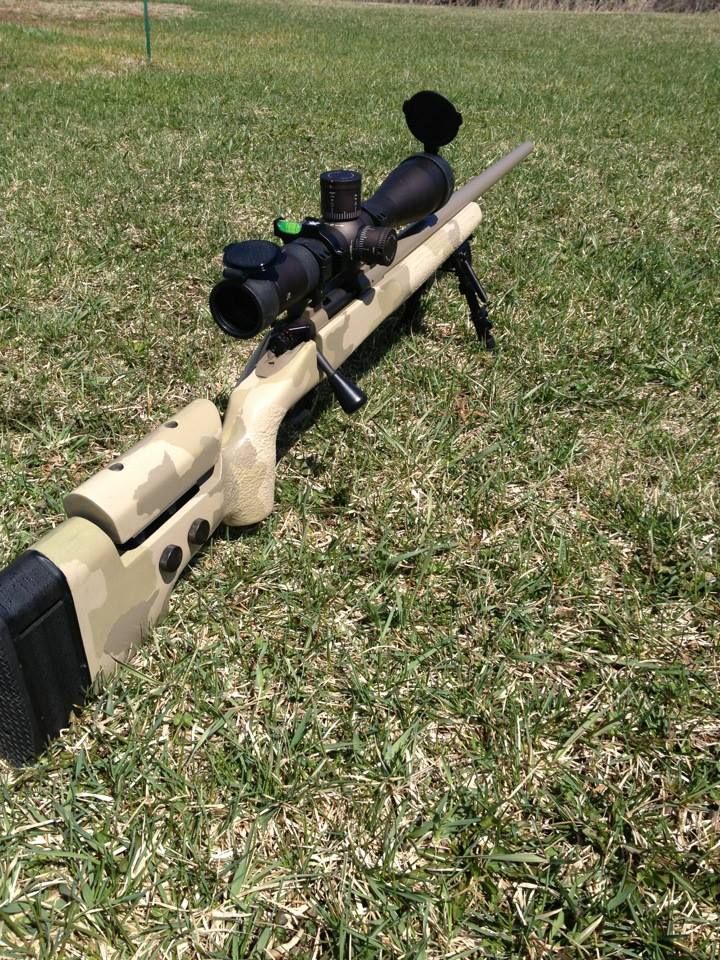"Blueprinting, what does it consist of?" Basically good bit of cash for paying a skilled machinist to do the job to the with the amount of precision that that can make the improvement in accuracy that only the very best marksmen can take advantage of.
Indicating to bolt in a fixture the lathe to .0001-.0002 and removing just enough to square the bolt face and lugs. This can be very time consuming and tedious work, and most importantly a machine operator that is quality minded enough to do things in an excellent manner.
Then squaring the bolt lugs and bolt face.
Setting up the receiver in a fixture that will indicate it to the same degree of precision. Single point cutting the receiver threads true to that axis, again to
.0001-.0002. taking small cuts to remove as little material as possible.
Single point cutting the receiver face, again removing as little material as possible.
Reaming the receiver to be true on that axis and shimming the bolt body for about .002 and turning to the above same level of accuracy/clearance to ensure that everything locks up like a finely made bank vault.
Depending on the receiver, (Remingtons will require some extremely accurate measuring to cut the bolt face recess, and diameter) then indicating the barrel with a spider, again to the same precision .0001-.0002.
Single point turning and threading the barrel tenon and shoulder so that the receiver screws on with no wiggle or slop. Again, when you are getting close, time to screw the receiver on and check it to make sure that is screws on with no slop or wiggle. This is best done a little at a time because you can't put it back after you turn it off. With remingtons, cutting the recess in the barrel for the bolt face to engage into "Three rings of steel"
Then cutting the chamber with the barrel indicated as close as possible to .0001-.0002. Cutting slowly and again, when you get close, checking the head space.
That kind of basically covers it. As you can see, people that are capable and skilled enough to accomplish it (with a mind set for excellence in how they do things) usually aren't cheap as the tools and equipment involved are not cheap.
And time- Time is money. If you are talking about real blueprinting, then this is a very basic explanation of the process. There are other tools and reamers made for the above operations that cut to predetermined sizes, some even made for use with a hand drill.

This is what you get when you buy a Borden, Pierce, Stiller, etc.
Back to the time is money. Some folks don't like to make what they call "sissy cuts" as shop time is money. It will be put together there, but that is a production attitude which you can get in a factory rifle. If you find someone cheap and fast, then just buy a factory action.
Guys that do this stuff right are artisan/craftsman type folks, perfectionist if you will. It bothers them if things are not as near close to perfect as possible, it keeps them from sleeping at night if it's not the very best job.
You pay for it, and after all, that level of skill demands it.
They usually expect a rifle done this way to shoot .5 MOA. But they are usually not going to warranty that.
This is why I like the Savage setup. They are usually fairly straight, you can lap the lugs yourself since you can then reset the headspace without re-cutting the barrel shoulder. Just screw in in a hair more.
Indicate and true bolt face and lugs, floating bolt head adequately addresses the rest.
If you are not a serious pro, you likely will not be able to shoot the above mentioned expertly machined job any better that the savage with a good barrel.
Good optics will do more to improve your shooting than a custom rifle will.
Unless you are someone who has spent their life shooting a heavy match rifle as a career or a professional competitor, Then you might shoot irons as good.
To me, Iron sights are for pistols and .30-30s. I agree with the person above who said get a good scope. It will help you learn to shoot better.

